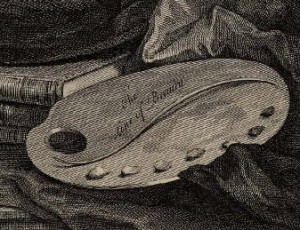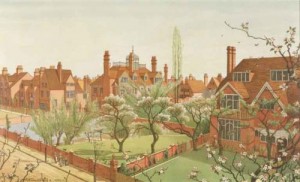William Hogarth and the Aesthetic Movement |
|||||
How the artist inspired a Victorian view of beauty
The exhibition at the Victoria & Albert Museum, The Cult of Beauty:The Aesthetic Movement 1860 to 1900 runs until 17 July. The exhibition shows the development of the Aesthetic Movement influencing the design and furnishing of the home, dress, literature and painting. Why would this be of interest to devotees of William Hogarth? For example, William Michael Rossetti wrote to John Brett in January 1858 to let him know that Hogarth’s House in Chiswick was up for rent at £25 a year. He said that his brother, Dante Gabriel Rossetti (who features in the exhibition), “had some thoughts of it once and looked it over and liked it. . . He thought it would be quite available for an artist with a few alterations”. The letter will be included in the new displays when Hogarth’s House re-opens. Alfred Dawson, who ran the Typographic Printing Company from a small works just over the garden wall of Hogarth’s House, bought the building in 1890, restored it and let it to a nurseryman. Dawson, who had developed a technique for the photographic reproduction of works of art, took as an apprentice the young Emery Walker. You can visit Walker’s House at 7 Hammersmith Terrace whose astonishingly well-preserved interior shows the influence of Aesthetic Movement and Arts & Crafts style. The house has a vine said to be grown from a cutting of Hogarth’s, probably through the connection to Dawson.
The Preservation Committee chairman was George Haité whose extraordinary fabric design incorporating bats and sunflowers, has been on sale as a souvenir of the exhibition. Amongst other supporters of the campaign were Walter Crane, Frederick George Stephens, Charles Fairfax Murray, Charles Holme, Harry Furniss, John Hassall and John Leighton. Though this group did not raise the funds to buy the House, local resident Lieut. Col. Shipway did and opened it as a museum in 1904. Amongst the first visitors were numerous Bedford Park residents. And John Leighton, who promised his copy of Hogarth’s 1740s self-portrait to a Hogarth museum if it were set up in the House, was true to his word – the painting is in poor condition, but if the funds can be found it will he restored in the next few months and also shown in the refurbished House. The Bedford Park lithograph is from Chiswick Local Studies Library July 13, 2011 |

 In 1900 Dawson sold the House but it was soon put up for auction as development land – Chiswick was growing rapidly at this period. A campaign was launched to save the House – artists and men of letters were prominent in the campaign, many of them from the nearby Aesthetic suburb of Bedford Park.
In 1900 Dawson sold the House but it was soon put up for auction as development land – Chiswick was growing rapidly at this period. A campaign was launched to save the House – artists and men of letters were prominent in the campaign, many of them from the nearby Aesthetic suburb of Bedford Park.